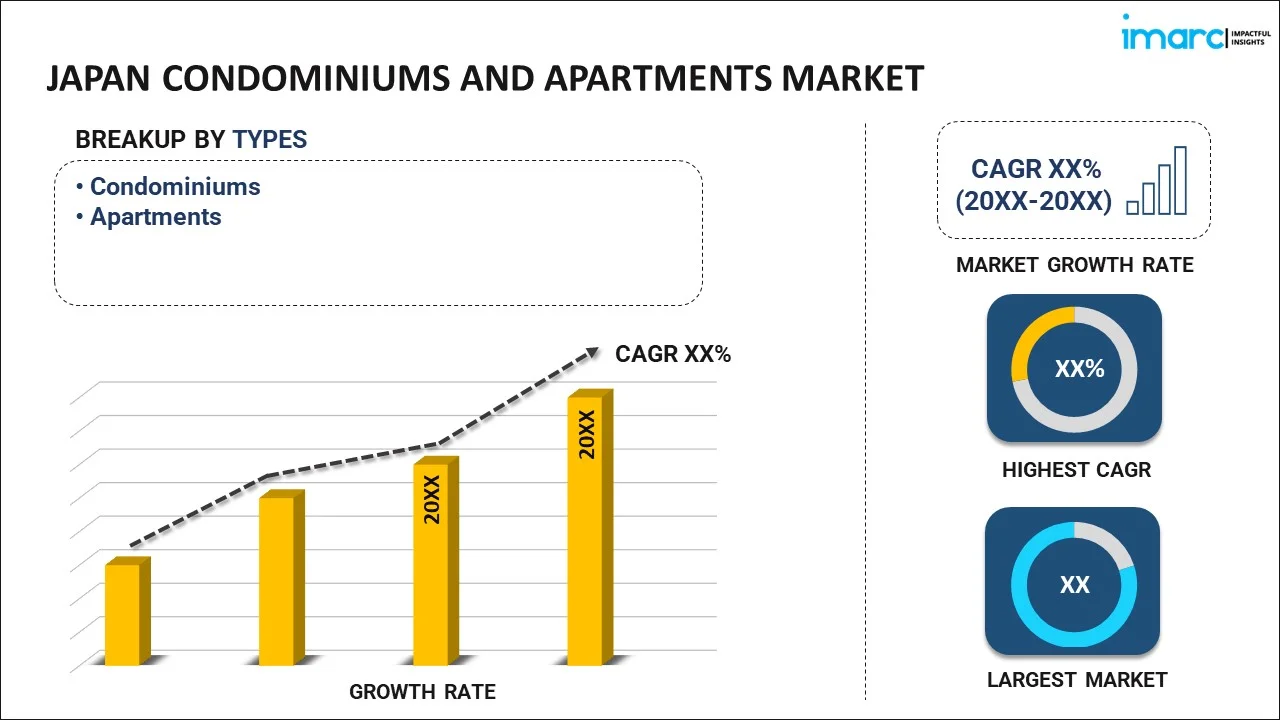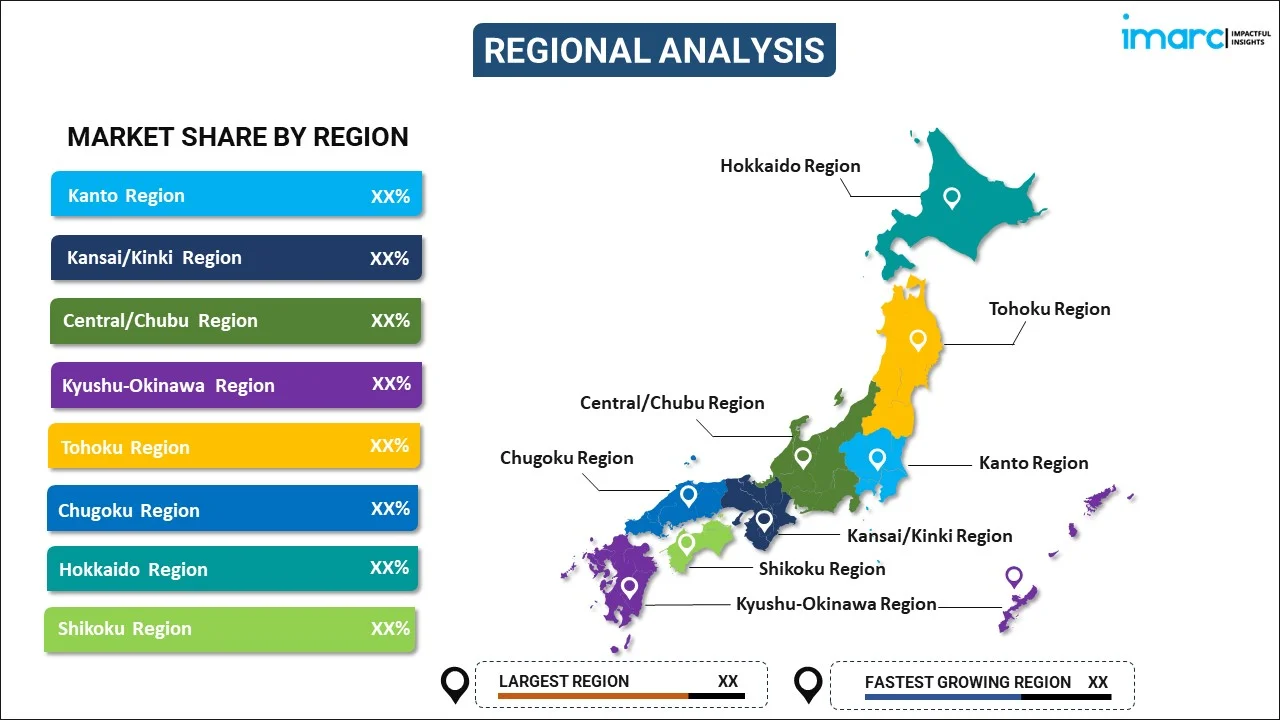
Japan Condominiums and Apartments Market Report by Type (Condominiums, Apartments), and Region 2026-2034
Market Overview:
Japan condominiums and apartments market size reached USD 57.8 Million in 2025. Looking forward, IMARC Group expects the market to reach USD 101.2 Million by 2034, exhibiting a growth rate (CAGR) of 6.42% during 2026-2034. The increasing prevalence of several contributing factors, such as urbanization, shifting lifestyles, investment appeal, demographic changes, construction innovations, etc., is primarily driving the market growth.
|
Report Attribute
|
Key Statistics
|
|---|---|
|
Base Year
|
2025 |
|
Forecast Years
|
2026-2034
|
|
Historical Years
|
2020-2025
|
| Market Size in 2025 | USD 57.8 Million |
| Market Forecast in 2034 | USD 101.2 Million |
| Market Growth Rate (2026-2034) | 6.42% |
Condominiums and apartments are both multifamily residential buildings that house multiple individual living units, but they have different ownership structures and often offer different lifestyles. An apartment is typically a rental unit within a building that is owned by a single entity, usually a corporation or individual, and tenants pay rent to the owner. Apartments can be part of large complexes with various amenities such as pools, gyms, and communal spaces, and tenants have limited responsibilities for maintenance and repairs. Conversely, a condominium, or condo, is a unit within a building that is individually owned. Condo owners hold a deed to their specific unit and often share ownership of common areas and amenities. They pay homeowners' association fees for maintenance and operation of shared spaces and have more control over their units compared to apartment renters, including the ability to sell. Condominiums can offer a sense of community and often come with luxurious amenities, and owners are responsible for their unit's maintenance and interior repairs. While both serve as residences, the distinction between condominiums and apartments primarily hinges on ownership, responsibilities, and lifestyle amenities.
Japan Condominiums and Apartments Market Trends:
The market for condominiums and apartments in Japan is experiencing burgeoning growth, driven predominantly by urbanization and the escalating demand for housing in metropolitan areas. As populations in cities continue to swell, the demand for apartments, typically more affordable and requiring less maintenance, significantly accelerates. Additionally, shifting lifestyle preferences and the rising inclination towards living in central urban locations with proximity to workplaces, educational institutions, and amenities also propel the demand for both condominiums and apartments. Moreover, the growing acceptance and preference for community living are reinforcing the appeal of condominiums, which often offer shared amenities and a sense of community. Concurrently, the surge in real estate investment, fueled by the promising returns and the stability associated with the housing market, acts as a catalyst for the development of both condominiums and apartments in Japan. Furthermore, the evolving demographics, marked by the increasing number of single-person households and people delaying homeownership, accentuate the trend towards renting apartments. Apart from this, the ongoing advancements in construction technologies that enable the development of sustainable and efficient buildings are expected to drive the condominiums and apartments market in Japan.
Japan Condominiums and Apartments Market Segmentation:
IMARC Group provides an analysis of the key trends in each segment of the market, along with forecasts at the country level for 2026-2034. Our report has categorized the market based on type.
Type Insights:

- Condominiums
- Apartments
The report has provided a detailed breakup and analysis of the market based on the type. This includes condominiums and apartments.
Regional Insights:

- Kanto Region
- Kansai/Kinki Region
- Central/Chubu Region
- Kyushu-Okinawa Region
- Tohoku Region
- Chugoku Region
- Hokkaido Region
- Shikoku Region
The report has also provided a comprehensive analysis of all the major regional markets, which include Kanto Region, Kansai/Kinki Region, Central/ Chubu Region, Kyushu-Okinawa Region, Tohoku Region, Chugoku Region, Hokkaido Region, and Shikoku Region.
Competitive Landscape:
The market research report has also provided a comprehensive analysis of the competitive landscape. Competitive analysis such as market structure, key player positioning, top winning strategies, competitive dashboard, and company evaluation quadrant has been covered in the report. Also, detailed profiles of all major companies have been provided. Some of the key players include:
- Asahi Kasei Homes Corp. (Asahi Kasei Corporation)
- Kajima Corporation
- Misawa Homes Co. Ltd.
- Nakano Corporation
- Nihon House Holdings Co. Ltd.
- Panasonic Homes Co. Ltd. (Panasonic Holdings Corporation)
- Sekisui House Ltd.
- Sumitomo Forestry Co. Ltd.
- Tama Home Co. Ltd.
- Yamada Homes Co. Ltd.
(Please note that this is only a partial list of the key players, and the complete list is provided in the report.)
Japan Condominiums and Apartments Market Report Coverage:
| Report Features | Details |
|---|---|
| Base Year of the Analysis | 2025 |
| Historical Period | 2020-2025 |
| Forecast Period | 2026-2034 |
| Units | Million USD |
| Scope of the Report | Exploration of Historical and Forecast Trends, Industry Catalysts and Challenges, Segment-Wise Historical and Predictive Market Assessment:
|
| Types Covered | Condominiums, Apartments |
| Regions Covered | Kanto Region, Kansai/Kinki Region, Central/Chubu Region, Kyushu-Okinawa Region, Tohoku Region, Chugoku Region, Hokkaido Region, Shikoku Region |
| Companies Covered | Asahi Kasei Homes Corp. (Asahi Kasei Corporation), Kajima Corporation, Misawa Homes Co. Ltd., Nakano Corporation, Nihon House Holdings Co. Ltd., Panasonic Homes Co. Ltd. (Panasonic Holdings Corporation), Sekisui House Ltd., Sumitomo Forestry Co. Ltd., Tama Home Co. Ltd., Yamada Homes Co. Ltd., etc. |
| Customization Scope | 10% Free Customization |
| Post-Sale Analyst Support | 10-12 Weeks |
| Delivery Format | PDF and Excel through Email (We can also provide the editable version of the report in PPT/Word format on special request) |
Key Questions Answered in This Report:
- How has the Japan condominiums and apartments market performed so far and how will it perform in the coming years?
- What has been the impact of COVID-19 on the Japan condominiums and apartments market?
- What is the breakup of the Japan condominiums and apartments market on the basis of type?
- What are the various stages in the value chain of the Japan condominiums and apartments market?
- What are the key driving factors and challenges in the Japan condominiums and apartments?
- What is the structure of the Japan condominiums and apartments market and who are the key players?
- What is the degree of competition in the Japan condominiums and apartments market?
Key Benefits for Stakeholders:
- IMARC’s industry report offers a comprehensive quantitative analysis of various market segments, historical and current market trends, market forecasts, and dynamics of the Japan condominiums and apartments market from 2020-2034.
- The research report provides the latest information on the market drivers, challenges, and opportunities in the Japan condominiums and apartments market.
- Porter's five forces analysis assist stakeholders in assessing the impact of new entrants, competitive rivalry, supplier power, buyer power, and the threat of substitution. It helps stakeholders to analyze the level of competition within the Japan condominiums and apartments industry and its attractiveness.
- Competitive landscape allows stakeholders to understand their competitive environment and provides an insight into the current positions of key players in the market.
Need more help?
- Speak to our experienced analysts for insights on the current market scenarios.
- Include additional segments and countries to customize the report as per your requirement.
- Gain an unparalleled competitive advantage in your domain by understanding how to utilize the report and positively impacting your operations and revenue.
- For further assistance, please connect with our analysts.
 Request Customization
Request Customization
 Speak to an Analyst
Speak to an Analyst
 Request Brochure
Request Brochure
 Inquire Before Buying
Inquire Before Buying




.webp)




.webp)












